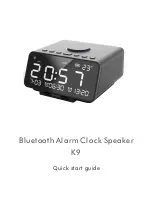
Spannungsversorgung:
Batteriebetrieb 9 V – Block
Empfohlene Batterien:
Zink-Kohle Type: Gold Peak #1604S.
Temperaturbereich:
0°C bis +40°C
Alarmsignal:
min. 85 dB(A)
Empfohlene Nutzungsdauer: Der gesamte Rauchwarnmelder muss getauscht werden, wenn
das Gerät länger als 10 Jahre installiert ist (überprüfen Sie das Austauschdatum auf dem
Produktetikett). Für ordnungsgemäße Funktion nach jedem Batteriewechsel mit der Prüftaste
testen.
• Nach Gebrauch können die Batterien unentgeltlich an den ausgewiesenen Batteriesammel-
stellen abgegeben werden.
• Der Endnutzer ist zu der Rückgabe der Batterien an den ausgewiesenen Sammelstellen
gesetzlich verpflichtet.
• Aufgrund unsachgemäßer Entsorgung können durch die in den Batterien enthaltenen Stoffe
erhebliche Gefahren für Gesundheit und Umwelt ausgehen.
• Durch die getrennte Sammlung und ordnungsgemäße Entsorgung gebrauchter Batterien
sollen die Gefahren für Mensch und Umwelt abgewendet werden.
Häufige Fragen
Was ist zu tun?
Warum hat der Rauchwarn-
Platzieren Sie Rauchwarnmelder in Küchen nur, falls ein
melder in der Küche häufig
Mindestabstand von 4 Metern zu Herden und offenen
Fehlalarm?
Feuerstätten möglich ist. Verbrennungspartikel, die auch
beim Kochen entstehen, können einen Alarm aktivieren.
Ohne ersichtlichen Grund
Reinigen Sie den Melder von außen mit einem Pinsel
hat der Rauchwarnmelder
oder leicht befeuchtetem Tuch. Überprüfen Sie, ob
ständig Fehlalarme?
die Batteriespannung ausreichend ist.
Warum blinkt die LED-Leuchte
Der Rauchwarnmelder führt alle 30 bis 40 Sekunden
ständig, obwohl die Batterie noch einen Selbsttest durch. Man erkennt dies am kurzen
ausreichend Spannung liefert? Aufblinken der LED.
Warum piept der Rauchwarn-
Der Rauchwarnmelder zeigt an, dass der Mindestwert der
melderalle 30 bis 40 Sekunden? Batteriespannung unterschritten ist. Tauschen Sie die Batterie.
Die Leistungserklärung 002/2017 zu diesem Produkt können Sie unter folgender Internetadresse
finden: http://iuqr.de/EIM-217
13.
Technische Daten
14.
Entsorgungs-
hinweise
15.
Häufige Fragen
Read the operating manual thoroughly and follow all fitting instructions carefully. Please follow
the instructions to ensure proper functioning. The EIM-217 operates according to the photoelec-
tronic principle and is powered by a replaceable 9V battery. It is used to identify and announce
the presence of smoke, and warn people in private homes both through sound and visually. A
piercing alarm sounds whenever the device detects the presence of smoke. Note that the device
detects the smoke, and not the flames, produced by a fire.
• Identifying and signalling household fires or for similar applications in residential
environments.
• DO NOT paint over or apply any other type of coating to the smoke detector.
• Use a small, soft paint brush or slightly-damp cloth, about twice a year, to remove any build-ups
of dirt and dust. Smoke detectors used in dusty conditions should be cleaned monthly. DO NOT
use compressed air for this purpose.
•
WARNING:
In order to prevent injuries, this device must be fastened reliably to the ceiling
according to the installation instructions.
• If the smoke detector is to work reliably, it MUST be fitted with the correct type of battery,
which must be replaced as required (see also point 7).
• Do not attempt to repair a defective smoke detector. Replace it with a new one.
• The batteries may not be exposed to direct sunlight.
1. Do not recharge non-rechargeable batteries.
2. Do not mix batteries of different types or new and used batteries.
3. Batteries must be installed with the correct polarity.
4. Empty batteries must be removed from the device.
5. Do not short-circuit the connection clamps.
6. Do not throw batteries into fire.
7. Swallowing batteries can be life threatening.
8. In case of leakage of battery acid, avoid contact with skin, eyes, and mucous membranes.
9. Used batteries must be recycled.
10. Do not expose the batteries to excessive heat such as from direct sunlight.
• Bedrooms. Install a smoke detector in each individual bedroom (not just in the hall leading to the
rooms).
• Hallways and staircases. A stairway can act as a chimney if fire breaks out, causing flames and
smoke to spread to other floors. Ensure that there is at least one smoke detector on each floor
of the building.
• Living and working areas.
• In rooms with sloping ceilings a distance of 50 to 100 cm to the apex must be observed .
• In rooms with partial pitched roof, if the horizontal ceiling is smaller or equal to 1m wide,
the smoke alarm is to be fitted as in the illustration . If the horizontal ceiling is larger
than 1 m wide, the smoke alarm is to be fitted in the middle of the horizontal ceiling
(see illustration ).
• Storage areas
• In rooms containing electrical equipment.
1.
Purpose
2.
Safety
precautions
3.
Battery
information
4.
Places where
smoke detectors
should be
installed
D
E
B
A
D





































